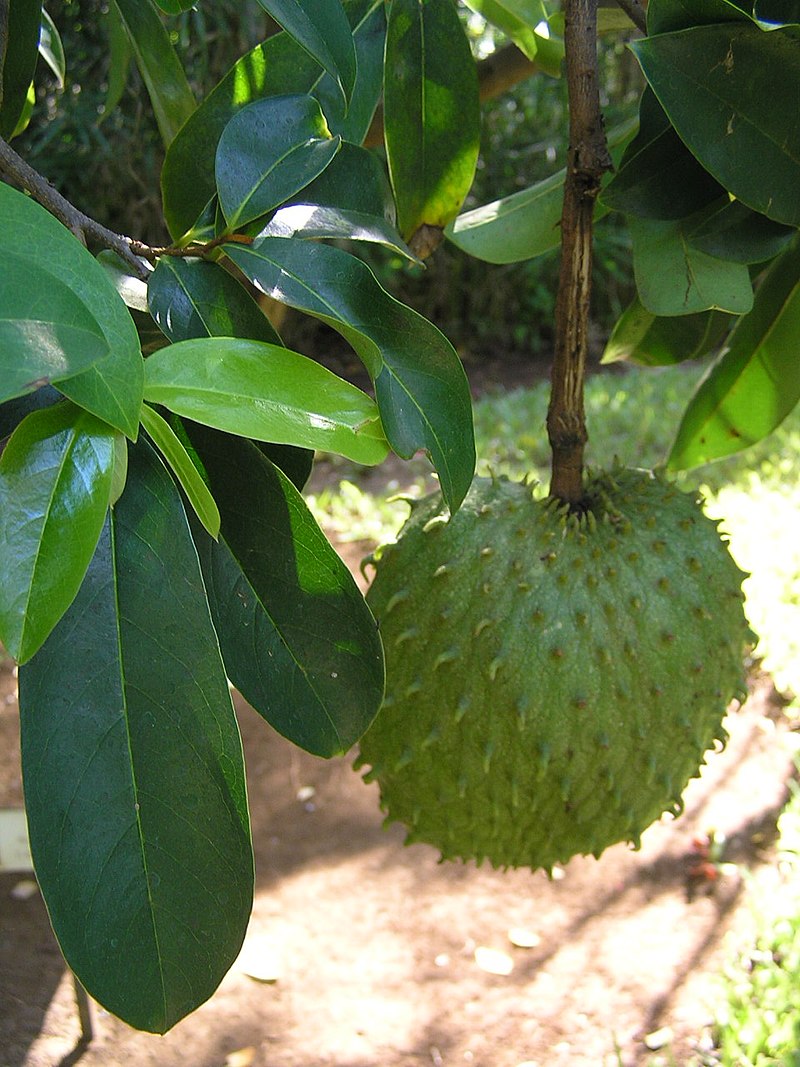Annona muricata

|
|
Annona muricata Common Names: Soursop, Graviola, Guanabana, Custard
Apple, Durian Blanda Scientific
Classification Kingdom: Plantae Phylum: Tracheophyta Class: Magnoliopsida Order: Magnoliales Family: Annonaceae Genus: Annona Species: A. muricata Synonyms: Annona macrocarpa Wercklé, Annona crassiflora Mart., Guanabanus muricatus M.Gómez, Annona bonplandiana Kunth, Annona cearensis Barb. Rodr., Annona muricata Vell. Morphological Description Annona muricata, commonly known as soursop, is a small, upright evergreen tree,
typically growing 5–10 m tall, with a slender, open crown. Its key features
include: · Stem: Young branches pubescent, becoming glabrous, with
greyish-brown bark · Leaves: Oblong to elliptic, 8–16 cm long, 3–7 cm wide, glossy dark
green above, pale below, with short, glabrous petioles (4–13 mm) · Flowers: Solitary or in small clusters, on woody peduncles (2–5 mm),
with thick, yellowish petals; outer petals ovate, non-overlapping, densely
hairy; inner petals oval, overlapping, finely pubescent · Fruit: Ovoid, dark green, spiny, up to 30 cm long, 15–20 cm wide,
with juicy, acidic, aromatic white pulp containing black seeds (1–2 cm long) Distribution and Habitat Annona muricata is native to the tropical Americas, including the Caribbean,
Central America, and northern South America, likely originating in the Antilles
or Amazonia. It is now widely cultivated in tropical and subtropical regions,
including Southeast Asia (e.g., Malaysia, Philippines), Africa (e.g., Nigeria,
Ghana), and the Pacific Islands. It thrives in: · Ecosystems: Rainforests, secondary forests, and cultivated orchards · Climate: Tropical to subtropical, with rainfall of 1,000–2,500 mm
annually and temperatures of 21–30°C · Soils: Well-drained, loamy to sandy, tolerating slightly acidic to
neutral pH (5.5–7.0) · Altitude: Sea level to 1,200 m Ethnopharmacology Annona muricata, commonly known as soursop or graviola, is a medicinal plant
widely used in traditional medicine across tropical regions. Various parts of
the plant—including the leaves, fruits, seeds, bark, and roots—are known for
their antioxidant, antimicrobial, anti-inflammatory, analgesic, antidiabetic, antiparasitic,
and anticancer properties. Traditionally, decoctions of the leaves and bark are
used to treat fevers, malaria, hypertension, pain, respiratory illnesses, and
gastrointestinal disorders such as diarrhea and dysentery. Soursop has gained
particular attention for its potential anticancer activity, attributed mainly
to compounds called annonaceous acetogenins, which have been shown in
laboratory studies to inhibit the growth of certain cancer cells. Phytochemical
studies also reveal the presence of alkaloids, flavonoids, tannins, and
saponins, contributing to its broad medicinal effects. Despite its promising
traditional and experimental uses, more clinical research is needed to fully
verify its efficacy and safety, especially regarding long-term consumption. · Anticancer
Activity: Extracts from various
parts of Annona muricata have shown cytotoxic effects against multiple cancer
cell lines, including breast, prostate, and colon cancers. Mechanisms involve
the induction of apoptosis and inhibition of cancer cell proliferation (Ilango
et al., 2022). · Antidiabetic
Effects: Leaf and fruit extracts
have demonstrated hypoglycemic effects in diabetic animal models. Mechanisms
include inhibition of α-glucosidase and α-amylase enzymes, enhancing insulin
secretion, and improving glucose uptake (Florence et al., 2014). · Antioxidant
Properties: High levels of phenolic
compounds in A. muricata contribute to its antioxidant activity, scavenging
free radicals and protecting against oxidative stress (Hartati et al., 2024). · Antimicrobial
Activity: Extracts have exhibited
antibacterial and antifungal activities against various pathogens, supporting
traditional uses in treating infections (Abdel-Rahman et al., 2019). · Antiulcer
and Gastroprotective Effects: Studies have shown that A. muricata extracts can protect against
gastric ulcers in animal models by enhancing mucosal defense mechanisms and
reducing oxidative damage (Moghadamtousi et al., 2014). ⚠ Toxicity Profile: While
A. muricata has demonstrated various therapeutic potentials, certain compounds,
particularly annonacin (a type of acetogenin), have been associated with
neurotoxic effects. High consumption levels have been linked to atypical
Parkinsonism in some populations. Additionally, excessive intake may lead to
hypotension and hypoglycemia. Therefore, caution is advised, especially with
long-term or high-dose use (Caparros-Lefebvre & Elbaz, 1999).) Additional Uses · Culinary: The fruit’s juicy, aromatic pulp is used in juices,
smoothies, ice creams, candies, and desserts across Nigeria, Brazil, and
Malaysia. Its flavor blends strawberry, pineapple, and citrus notes · Insecticidal: Seed and leaf extracts, rich in acetogenins, are used as
natural insecticides against pests like German cockroaches in Cameroon and
Nigeria · Agroforestry: The tree is planted in home gardens and agroforestry systems
for shade and soil improvement in Ghana and the Philippines · Industrial: Fruit pulp is processed into beverages and nutraceuticals;
seed oils are explored for cosmetic applications in Malaysia References
External Links More Pictures |
|
| Compounds of Annona muricata | |
| References |